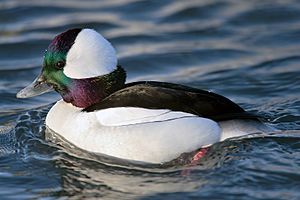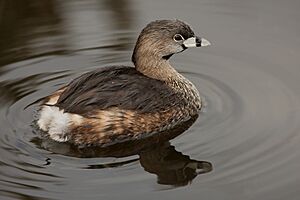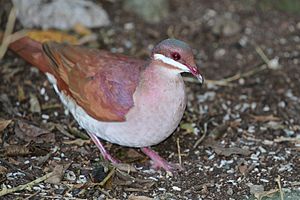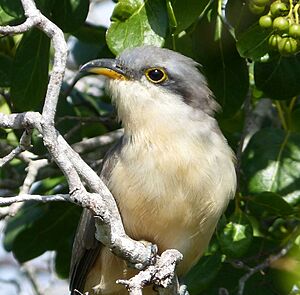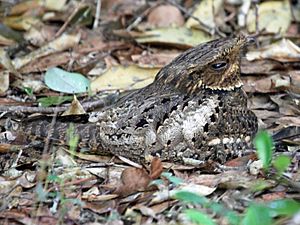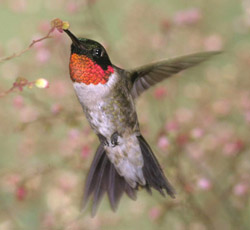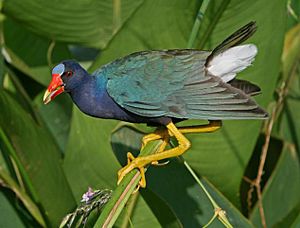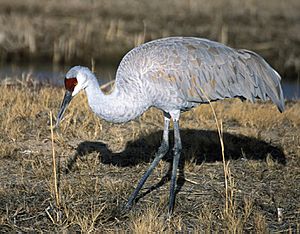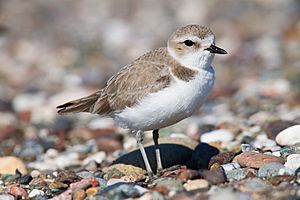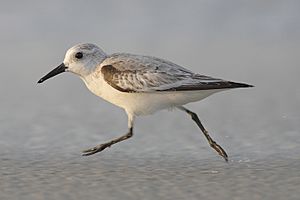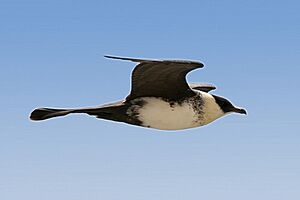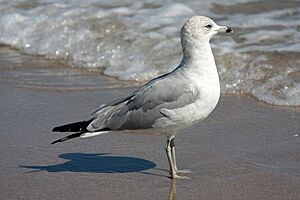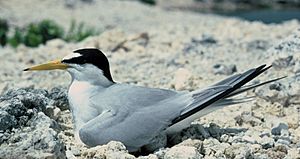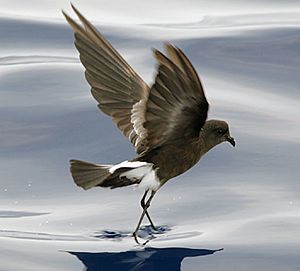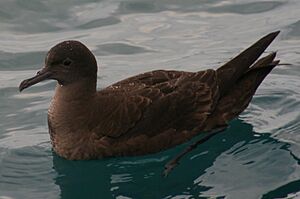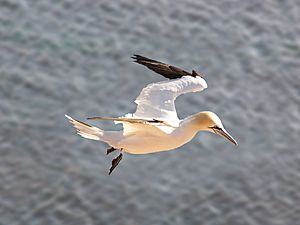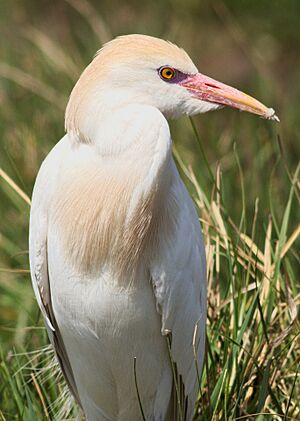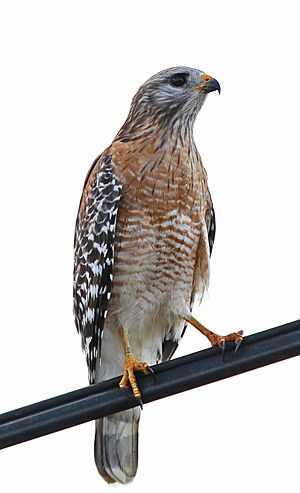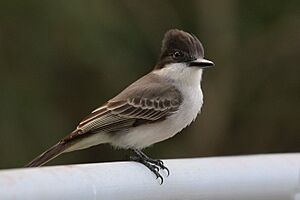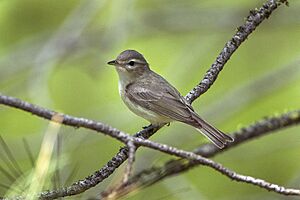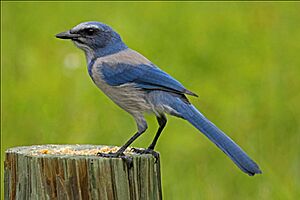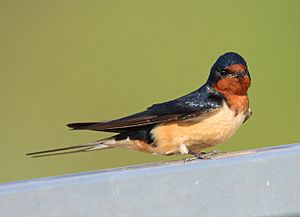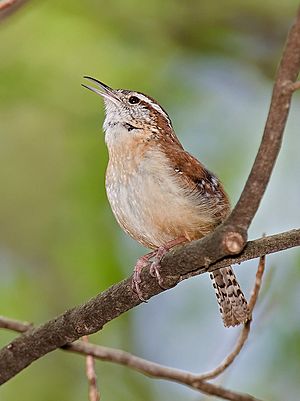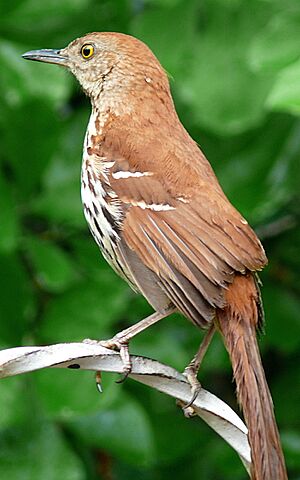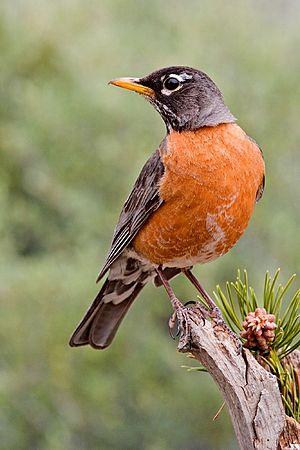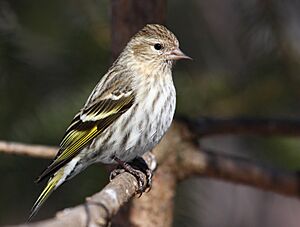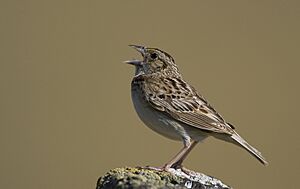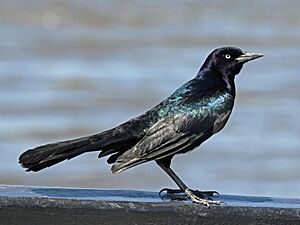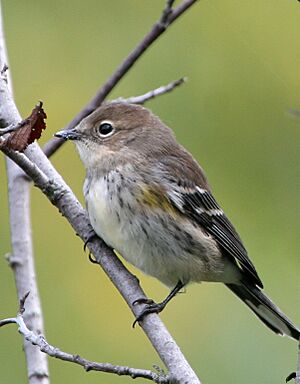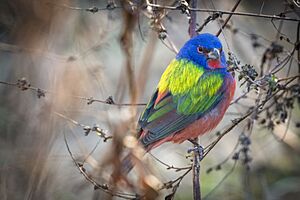List of birds of Florida facts for kids
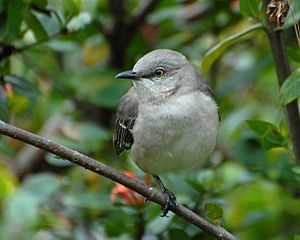
Welcome to the amazing world of Florida's birds! This list shows all the different kinds of birds that have been seen and officially recorded in the sunny state of Florida. The Florida Ornithological Society Records Committee (FOSRC) keeps track of these birds.
As of November 2022, there are 539 different bird species on the official list! That's a lot of birds!
Here's what some of the letters next to the bird names mean:
- (A) Accidental: This bird doesn't usually live in Florida. It's like a rare visitor who showed up by accident!
- (I) Introduced: Humans brought this bird to North America, and now it lives and breeds in Florida.
- (E) Extinct: This bird no longer exists anywhere in the world. It's sadly gone forever.
- (e) Extirpated: This bird no longer lives in Florida, but you can still find it in other parts of the world.
More than 100 other "exotic species" (birds from other places) also fly freely in Florida's wild areas, according to the FOSRC. This list follows the official bird checklist from the American Ornithological Society (AOS).
Contents
- Ducks, Geese, and Waterfowl
- New World Quail
- Pheasants, Grouse, and Allies
- Flamingoes
- Grebes
- Pigeons and Doves
- Cuckoos
- Nightjars and Allies
- Potoos
- Swifts
- Hummingbirds
- Rails, Gallinules, and Coots
- Limpkin
- Cranes
- Thick-knees
- Stilts and Avocets
- Oystercatchers
- Lapwings and Plovers
- Jacanas
- Sandpipers and Allies
- Pratincoles and Coursers
- Skuas and Jaegers
- Auks, Murres, and Puffins
- Gulls, Terns, and Skimmers
- Tropicbirds
- Loons
- Albatrosses
- Southern Storm-Petrels
- Northern Storm-Petrels
- Shearwaters and Petrels
- Storks
- Frigatebirds
- Boobies and Gannets
- Anhingas
- Cormorants and Shags
- Pelicans
- Herons, Egrets, and Bitterns
- Ibises and Spoonbills
- New World Vultures
- Osprey
- Hawks, Eagles, and Kites
- Barn-Owls
- Owls
- Trogons
- Kingfishers
- Bee-eaters
- Jacamars
- Woodpeckers
- Falcons and Caracaras
- New World and African Parrots
- Old World Parrots
- Tityras and Allies
- Tyrant Flycatchers
- Antbirds
- Ovenbirds
- Vireos, Shrike-Babblers, and Erpornis
- Shrikes
- Crows, Jays, and Magpies
- Tits, Chickadees, and Titmice
- Larks
- Swallows
- Long-tailed Tits
- Bulbuls
- Kinglets
- Waxwings
- Silky-Flycatchers
- Nuthatches
- Treecreepers
- Gnatcatchers
- Wrens
- Mockingbirds and Thrashers
- Starlings
- Thrushes and Allies
- Old World Flycatchers
- Waxbills and Allies
- Old World Sparrows
- Wagtails and Pipits
- Finches, Euphonias, and Allies
- Longspurs and Snow Buntings
- Old World Buntings
- New World Sparrows
- Spindalises
- Yellow-breasted Chat
- Troupials and Allies
- New World Warblers
- Cardinals and Allies
- Tanagers and Allies
- Notable Exotic Birds
- See Also
Ducks, Geese, and Waterfowl
Order: Anseriformes Family: Anatidae
This family includes ducks, geese, and swans. These birds are super good at living in water. They have webbed feet for swimming, flat bills for finding food, and special oily feathers that keep them dry.
- White-faced whistling duck, Dendrocygna viduata (A)
- Black-bellied whistling-duck, Dendrocygna autumnalis
- West Indian whistling duck, Dendrocygna arborea (A)
- Fulvous whistling-duck, Dendrocygna bicolor
- Snow goose, Anser caerulescens
- Ross's goose, Anser rossii
- Greater white-fronted goose, Anser albifrons
- Graylag goose, Anser anser (A)
- Brant, Branta bernicla (A)
- Barnacle goose, Branta leucopsis (A)
- Cackling goose, Branta hutchinsonii (A)
- Canada goose, Branta canadensis
- Trumpeter swan, Cygnus buccinator (A)
- Tundra swan, Cygnus columbianus (A)
- Whooper swan, Cygnus cygnus (A)
- Egyptian goose, Alopochen aegyptiaca (I)
- Muscovy duck, Cairina moschata (I)
- Wood duck, Aix sponsa
- Garganey, Spatula querquedula (A)
- Blue-winged teal, Spatula discors
- Cinnamon teal, Spatula cyanoptera
- Northern shoveler, Spatula clypeata
- Gadwall, Mareca strepera
- Eurasian wigeon, Mareca penelope
- American wigeon, Mareca americana
- Mallard, Anas platyrhynchos
- Eastern spot-billed duck, Anas zonorhyncha (A)
- American black duck, Anas rubripes
- Mottled duck, Anas fulvigula
- White-cheeked pintail, Anas bahamensis (A)
- Northern pintail, Anas acuta
- Green-winged teal, Anas crecca
- Common teal, A. c. crecca (A)
- Canvasback, Aythya valisineria
- Redhead, Aythya americana
- Ring-necked duck, Aythya collaris
- Tufted duck, Aythya fuligula (A?)
- Greater scaup, Aythya marila
- Lesser scaup, Aythya affinis
- King eider, Somateria spectabilis (A)
- Common eider, Somateria mollissima
- Harlequin duck, Histrionicus histrionicus (A)
- Surf scoter, Melanitta perspicillata
- White-winged scoter, Melanitta deglandi
- Black scoter, Melanitta americana
- Long-tailed duck, Clangula hyemalis
- Bufflehead, Bucephala albeola
- Common goldeneye, Bucephala clangula
- Barrow's goldeneye, Bucephala islandica (A)
- Labrador duck, Camptorhynchus labradorius (E)
- Hooded merganser, Lophodytes cucullatus
- Common merganser, Mergus merganser (A)
- Red-breasted merganser, Mergus serrator
- Masked duck, Nomonyx dominicus (A)
- Ruddy duck, Oxyura jamaicensis
New World Quail
Order: Galliformes Family: Odontophoridae
New World quails are small, plump birds that live on the ground. They look similar to Old World quails but are not closely related.
- Northern bobwhite, Colinus virginianus
Pheasants, Grouse, and Allies
Order: Galliformes Family: Phasianidae
This family includes pheasants and their relatives. They are ground birds that vary in size. Many are hunted for sport or raised for food.
- Wild turkey, Meleagris gallopavo
- Ruffed grouse, Bonasa umbellus (A?)
- Greater prairie-chicken, Tympanuchus cupido (e)
- Heath hen, T. c. cupido (E)
Flamingoes
Order: Phoenicopteriformes Family: Phoenicopteridae
Flamingoes are tall, social wading birds, usually about 3 to 5 feet (1 to 1.5 meters) tall. They live in warm parts of the world. Flamingos eat shellfish and algae by filtering them from the water with their unique, upside-down beaks.
- American flamingo, Phoenicopterus ruber
Grebes
Order: Podicipediformes Family: Podicipedidae
Grebes are small to medium-sized diving birds that live in freshwater. They have special lobed toes that make them excellent swimmers and divers. However, their feet are set far back on their bodies, so they are clumsy on land.
- Least grebe, Tachybaptus dominicus (A)
- Pied-billed grebe, Podilymbus podiceps
- Horned grebe, Podiceps auritus
- Red-necked grebe, Podiceps grisegena (A)
- Eared grebe, Podiceps nigricollis
- Western grebe, Aechmorphorus occidentalis (A)
Pigeons and Doves
Order: Columbiformes Family: Columbidae
Pigeons and doves are birds with sturdy bodies, short necks, and thin bills. They are found all over the world.
- Rock pigeon, Columba livia (I)
- Common wood pigeon, Columba palumbus (A)
- Scaled pigeon, Patagioenas speciosa (A)
- Scaly-naped pigeon, Patagioenas squamosa (A)
- White-crowned pigeon, Patagioenas leucocephala
- Band-tailed pigeon, Patagioenas fasciata (A)
- European turtle-dove, Streptopelia turtur (A)
- Eurasian collared-dove, Streptopelia decaocto (I)
- Laughing dove, Streptopelia senegalensis (A)
- Passenger pigeon, Ectopistes migratorius (E)
- Inca dove, Columbina inca (A)
- Common ground dove, Columbina passerina
- Ruddy ground dove, Columbina talpacoti (A)
- Blue-headed quail-dove, Starnoenas cyanocephala (A)
- Ruddy quail-dove, Geotrygon montana (A)
- Key West quail-dove, Geotrygon chrysia (A)
- Blue ground dove, Claravis pretiosa (A)
- White-tipped dove, Leptotila verreauxi (A)
- White-winged dove, Zenaida asiatica
- Eared dove, Zenaida auriculata (A)
- Zenaida dove, Zenaida aurita (A)
- Mourning dove, Zenaida macroura
Cuckoos
Order: Cuculiformes Family: Cuculidae
This family includes cuckoos, roadrunners, and anis. These birds have slender bodies, long tails, and strong legs.
- Greater ani, Crotophaga major (A)
- Smooth-billed ani, Crotophaga ani
- Groove-billed ani, Crotophaga sulcirostris
- Common cuckoo, Cuculus canorus (A)
- Pheasant cuckoo, Dromococcyx phasianellus (A)
- Squirrel cuckoo, Piaya cayana (A)
- Dark-billed cuckoo, Coccyzus melacoryphus (A)
- Yellow-billed cuckoo, Coccyzus americanus
- Mangrove cuckoo, Coccyzus minor
- Black-billed cuckoo, Coccyzus erythropthalmus
Nightjars and Allies
Order: Caprimulgiformes Family: Caprimulgidae
Nightjars are medium-sized birds that are active at night. They usually nest on the ground. They have long wings, short legs, and very short bills. Their soft feathers are colored to blend in with bark or leaves, helping them hide.
- Lesser nighthawk, Chordeiles acutipennis
- Common nighthawk, Chordeiles minor
- Antillean nighthawk, Chordeiles gundlachii
- Common pauraque, Nyctidromus albicollis (A)
- Common poorwill, Phalaenoptilus nuttallii (A)
- Buff-collared nightjar, Antrostomus ridgwayi (A)
- Chuck-will's-widow, Antrostomus carolinensis
- Eastern whip-poor-will, Antrostomus vociferus
Potoos
Order: Nyctibiiformes Family: Nyctibiidae
Potoos are large birds related to nightjars. They hunt insects at night. They don't have the bristles around their mouths that true nightjars do.
- Common potoo, Nyctibius griseus (A?)
Swifts
Order: Apodiformes Family: Apodidae
Swifts are small birds that spend most of their lives flying. They have very short legs and almost never land on the ground. Instead, they perch on vertical surfaces. Many swifts have long, swept-back wings that look like a crescent moon.
- Black swift, Cypseloides niger (A)
- White-collared swift, Streptoprocne zonaris (A)
- Gray-rumped swift, Chaetura cinereiventris (A)
- Chimney swift, Chaetura pelagica
- Vaux's swift, Chaetura vauxi (A)
- Common swift, Apus apus (A)
- Alpine swift, Apus melba (A)
- White-throated swift, Aeronautes saxatalis (A)
- Antillean palm-swift, Tachornis phoenicobia (A)
Hummingbirds
Order: Apodiformes Family: Trochilidae
Hummingbirds are tiny birds famous for hovering in mid-air. They flap their wings incredibly fast. They are the only birds that can fly backward!
- White-necked jacobin, Florisuga mellivora (A)
- Mexican violetear, Colibri thalassinus (A)
- Bahama woodstar, Calliphlox evelynae (A)
- Green-breasted mango, Anthracothorax prevostii (A)
- Black-throated mango, Anthracothorax nigricollis (hypothetical)
- Rivoli's hummingbird, Eugenes fulgens (A)
- Blue-throated mountain-gem, Lampornis clemenciae (A)
- Ruby-throated hummingbird, Archilochus colubris
- Black-chinned hummingbird, Archilochus alexandri
- Anna's hummingbird, Calypte anna (A)
- Costa's hummingbird, Calypte costae (A)
- Calliope hummingbird, Selasphorus calliope (A)
- Rufous hummingbird, Selasphorus rufus
- Allen's hummingbird, Selasphorus sasin (A)
- Broad-tailed hummingbird, Selasphorus platycercus (A)
- Broad-billed hummingbird, Cynanthus latirostris (A)
- Cuban emerald, Riccordia ricordii (A)
- White-eared hummingbird, Basilinna leucotis (A)
- Antillean crested hummingbird, Orthorhyncus cristatus (A)
- Buff-bellied hummingbird, Amazila yucatanensis
Rails, Gallinules, and Coots
Order: Gruiformes Family: Rallidae
This large family includes rails, crakes, coots, and gallinules. They are usually found in thick plants near lakes, swamps, or rivers. They are often shy and hard to spot. Most have strong legs with long toes, short rounded wings, and are not very strong fliers.
- Spotted rail, Pardirallus maculatus (A)
- Gray-cowled wood-rail, Aramides cajaneus (e)
- Clapper rail, Rallus crepitans
- King rail, Rallus elegans
- Virginia rail, Rallus limicola
- Corn crake, Crex crex (A)
- Sora, Porzana carolina
- Common gallinule, Gallinula galeata
- American coot, Fulica americana
- Purple gallinule, Porphyrio martinicus
- Purple swamphen, Porphyrio poliocephalus (I)
- Yellow rail, Coturnicops noveboracensis (A)
- Yellow-breasted crake, Hapalocrex flaviventer (A)
- Gray-breasted crake, Laterallus exilis (e)
- Black rail, Laterallus jamaicensis
Limpkin
Order: Gruiformes Family: Aramidae
The limpkin is a unique bird that looks like a large rail. It is found in marshes with trees or bushes in the Caribbean, South America, and southern Florida.
- Limpkin, Aramus guarauna
Cranes
Order: Gruiformes Family: Gruidae
Cranes are large, tall birds with long legs and necks. Unlike herons, cranes fly with their necks stretched out. Many cranes have special, loud "dances" to find a mate. They might also dance just for fun!
- Demoiselle crane, Anthropoides virgo (A)
- Sandhill crane, Antigone canadensis
- Whooping crane, Grus americana (reintroduced)
Thick-knees
Order: Charadriiformes Family: Burhinidae
Thick-knees are a group of wading birds mostly found in tropical areas. They are medium to large birds with strong black or yellow-black bills, big yellow eyes, and feathers that help them blend in. Even though they are waders, most prefer dry or semi-dry places.
- Double-striped thick-knee, Burhinus bistriatus (A)
Stilts and Avocets
Order: Charadriiformes Family: Recurvirostridae
This family includes avocets and stilts. Avocets have long legs and bills that curve upward. Stilts have super long legs and long, thin, straight bills.
- Black-necked stilt, Himantopus mexicanus
- American avocet, Recurvirostra americana
Oystercatchers
Order: Charadriiformes Family: Haematopodidae
Oystercatchers are large, easy-to-spot, and noisy birds. They have strong bills that they use to smash or pry open molluscs (like clams).
- Eurasian oystercatcher, Haematopus ostralegus (A)
- American oystercatcher, Haematopus palliatus
- Black oystercatcher, Haematopus bachmani (A)
Lapwings and Plovers
Order: Charadriiformes Family: Charadriidae
This family includes plovers, dotterels, and lapwings. They are small to medium-sized birds with compact bodies, short thick necks, and long, pointed wings. They usually live in open areas, often near water.
- Northern lapwing, Vanellus vanellus (A)
- Southern lapwing, Vanellus chilensis (A)
- Black-bellied plover, Pluvialis squatarola
- European golden-plover, Pluvialis apricaria (A)
- American golden-plover, Pluviali dominicas
- Pacific golden-plover, Pluvialis fulva (A)
- Killdeer, Charadrius vociferus
- Semipalmated plover, Charadrius semipalmatus
- Piping plover, Charadrius melodus
- Lesser sand-plover, Charadrius mongolus (A)
- Greater sand-plover, Charadrius leschenaultii (A)
- Wilson's plover, Charadrius wilsonia
- Collared plover, Charadrius collaris (A)
- Snowy plover, Charadrius nivosus
- Mountain plover, Charadrius montanus (A)
Jacanas
Order: Charadriiformes Family: Jacanidae
Jacanas are a family of wading birds found in tropical areas. You can recognize them by their huge feet and claws. These help them walk on floating plants in shallow lakes, which is where they like to live.
- Northern jacana, Jacana spinosa (A)
Sandpipers and Allies
Order: Charadriiformes Family: Scolopacidae
This is a large and varied family of small to medium-sized shorebirds. It includes sandpipers, curlews, godwits, and more. Most of them eat small bugs they find in mud or sand. Different lengths of legs and bills allow many species to feed in the same area without fighting over food.
- Upland sandpiper, Bartramia longicauda
- Whimbrel, Numenius phaeopus
- Long-billed curlew, Numenius americanus
- Eurasian curlew, Numenius arquata (hypothetical)
- Bar-tailed godwit, Limosa lapponica (A)
- Black-tailed godwit, Limosa limosa (A)
- Hudsonian godwit, Limosa haemastica
- Marbled godwit, Limosa fedoa
- Ruddy turnstone, Arenaria interpres
- Red knot, Calidris canutus
- Surfbird, Calidris virgata (A)
- Ruff, Calidris pugnax
- Sharp-tailed sandpiper, Calidris acuminata (A)
- Stilt sandpiper, Calidris himantopus
- Curlew sandpiper, Calidris ferruginea (A)
- Red-necked stint, Calidris ruficollis (A)
- Sanderling, Calidris alba
- Dunlin, Calidris alpina
- Purple sandpiper, Calidris maritima
- Baird's sandpiper, Calidris bairdii
- Little stint, Calidris minuta (A)
- Least sandpiper, Calidris minutilla
- White-rumped sandpiper, Calidris fuscicollis
- Buff-breasted sandpiper, Calidris subruficollis
- Pectoral sandpiper, Calidris melanotos
- Semipalmated sandpiper, Calidris pusilla
- Western sandpiper, Calidris mauri
- Short-billed dowitcher, Limnodromus griseus
- Long-billed dowitcher, Limnodromus scolopaceus
- American woodcock, Scolopax minor
- Wilson's snipe, Gallinago delicata
- Spotted sandpiper, Actitis macularius
- Solitary sandpiper, Tringa solitaria
- Gray-tailed tattler, Tringa brevipes (A)
- Lesser yellowlegs, Tringa flavipes
- Willet, Tringa semipalmata
- Spotted redshank, Tringa erythropus (A)
- Common greenshank, Tringa nebularia (A)
- Greater yellowlegs, Tringa melanoleuca
- Wilson's phalarope, Phalaropus tricolor
- Red-necked phalarope, Phalaropus lobatus
- Red phalarope, Phalaropus fulicarius
Pratincoles and Coursers
Order: Charadriiformes Family: Glareolidae
Pratincoles have short legs, very long pointed wings, and long forked tails. What's unusual for a wader (a bird that wades in water) is that they usually catch insects while flying, like swallows. Their short bills help them eat while flying. They fly fast and gracefully, like a swallow or a tern.
- Collared pratincole, Glareola pratincola (A)
Skuas and Jaegers
Order: Charadriiformes Family: Stercorariidae
Skuas are medium to large seabirds. They are usually gray or brown, sometimes with white marks on their wings. They have longish bills with hooked tips and webbed feet with sharp claws. They look like big, dark gulls but have a fleshy area above their upper bill. They are strong, acrobatic fliers.
- South polar skua, Stercorarius maccormicki (A)
- Pomarine jaeger, Stercorarius pomarinus
- Parasitic jaeger, Stercorarius parasiticus
- Long-tailed jaeger, Stercorarius longicaudus
Auks, Murres, and Puffins
Order: Charadriiformes Family: Alcidae
Alcids look a bit like penguins because they are black and white and stand upright. However, they are not closely related to penguins and can fly (except for one extinct type). Auks live on the open sea and only come to land to lay eggs and raise their young.
- Dovekie, Alle alle (A)
- Common murre, Uria aalge (A)
- Thick-billed murre, Uria lomvia (A)
- Razorbill, Alca torda (A)
- Great auk, Pinguinus impennis (E)
- Black guillemot, Cepphus grylle (A)
- Long-billed murrelet, Brachyrampus perdix (A)
- Marbled murrelet, Brachyramphus marmoratus (A)
- Ancient murrelet, Synthliboramphus antiquus (A)
- Atlantic puffin, Fratercula arctica (A)
Gulls, Terns, and Skimmers
Order: Charadriiformes Family: Laridae
The Laridae family includes gulls, terns, and skimmers. They are medium to large seabirds, usually gray or white, often with black marks on their heads or wings. They have strong, longish bills and webbed feet.
- Black-legged kittiwake, Rissa tridactyla (A)
- Sabine's gull, Xema sabini
- Bonaparte's gull, Chroicocephalus philadelphia
- Gray-hooded gull, Chroicocephalus cirrocephhalus (A)
- Black-headed gull, Chroicocephalus ridibundus (A)
- Little gull, Hydrocoleus minutus (A)
- Laughing gull, Leucophaeus atricilla
- Gray gull, Leucophaeus modestus (A)
- Franklin's gull, Leucophaeus pipixcan
- Audouin's gull, Ichthyaetus audouinii (A)
- Belcher's gull, Larus belcheri (A)
- Black-tailed gull, Larus crassirostris (A)
- Heermann's gull, Larus heermanni (A)
- Common gull, Larus canus (A)
- Ring-billed gull, Larus delawarensis
- California gull, Larus californicus (A)
- Herring gull, Larus argentatus
- "Vega gull", L. a. vega (A)
- Iceland gull, Larus glaucoides
- "Nominate Iceland gull", L. g. glaucoides (A)
- Thayer's gull, L. g. thayeri (A)
- Yellow-legged gull, Larus michahellis (A)
- Lesser black-backed gull, Larus fuscus
- Slaty-backed gull, Larus schistisagus (A)
- Glaucous gull, Larus hyperboreus
- Great black-backed gull, Larus marinus
- Kelp gull, Larus dominicanus (A)
- Brown noddy, Anous stolidus
- Black noddy, Anous minutus
- Sooty tern, Onychoprion fuscata
- Bridled tern, Onychoprion anaethetus
- Least tern, Sternula antillarum
- Gull-billed tern, Gelochelidon nilotica
- Caspian tern, Hydroprogne caspia
- White-winged tern, Chlidonias leucopterus (A)
- Whiskered tern, Chlidonias hybrida (A)
- Black tern, Chlidonias niger
- Large-billed tern, Phaetusa simplex (A)
- Roseate tern, Sterna dougallii
- Common tern, Sterna hirundo
- Arctic tern, Sterna paradisaea
- Forster's tern, Sterna forsteri
- Royal tern, Thalasseus maxima
- Sandwich tern, Thalasseus sandvicensis
- "Cayenne tern", T. s. eurygnathus (A)
- Elegant tern, Thalasseus elegans (A)
- Black skimmer, Rynchops niger
Tropicbirds
Order: Phaethontiformes Family: Phaethontidae
Tropicbirds are slender white birds that live in tropical oceans. They have very long central tail feathers. Their long wings and heads have black markings.
- White-tailed tropicbird, Phaethon lepturus
- Red-billed tropicbird, Phaeton aethereus (A)
Loons
Order: Gaviiformes Family: Gaviidae
Loons are aquatic birds, about the size of a large duck, but they are not related to ducks. They are mostly gray or black and have bills shaped like spears. Loons swim very well and fly well too, but they are clumsy on land because their legs are at the back of their bodies.
- Red-throated loon, Gavia stellata
- Arctic loon, Gavia arctica (A)
- Pacific loon, Gavia pacifica (A)
- Common loon, Gavia immer
- Yellow-billed loon, Gavia adamsii (A)
Albatrosses
Order: Procellariiformes Family: Diomedeidae
Albatrosses are among the biggest flying birds. The great albatrosses have the largest wingspans of any living birds.
- Yellow-nosed albatross, Thalassarche chlororhynchos (A)
- Black-browed albatross, Thalassarche melanophris (A)
- Wandering albatross, Diomedea exulans (hypothetical)
Southern Storm-Petrels
Order: Procellariiformes Family: Oceanitidae
Storm-petrels are the smallest seabirds. They are related to petrels. They eat tiny crustaceans and small fish from the water's surface, often while hovering. Their flight is fluttery, sometimes like a bat.
- Wilson's storm-petrel, Oceanites oceanicus
- White-bellied storm-petrel, Fregetta grallaria (A)
Northern Storm-Petrels
Order: Procellariiformes Family: Hydrobatidae
These storm-petrels look and act much like the southern storm-petrels. However, they are different enough genetically to be in their own family.
- European storm-petrel, Hydrobates pelagicus (A)
- Leach's storm-petrel, Hydrobates leucorhous
- Band-rumped storm-petrel, Hydrobates castro
Shearwaters and Petrels
Order: Procellariiformes Family: Procellariidae
Procellariids are the main group of medium-sized "true petrels." They have unique tubular nostrils.
- Northern fulmar, Fulmarus glacialis (A)
- Bermuda petrel, Pterodroma cahow (A)
- Black-capped petrel, Pterodoma hasitata
- Fea's petrel, Pterodroma feae (A)
- Bulwer's petrel, Bulweria bulwerii (A)
- Cory's shearwater, Calonectris diomedea
- Cape Verde shearwater, Calonectris edwardsii (A)
- Wedge-tailed shearwater, Ardenna pacifica (A)
- Short-tailed shearwater, Ardenna tenuirostris (A)
- Sooty shearwater, Ardenna griseus
- Great shearwater, Ardenna gravis
- Manx shearwater, Puffinus puffinus (A)
- Audubon's shearwater, Puffinus lherminieri
Storks
Order: Ciconiiformes Family: Ciconiidae
Storks are large, heavy, wading birds with long legs and necks. They have long, strong bills and wide wings. Unlike some other wading birds, storks do not have special "powder down" feathers to clean fish slime. Storks also cannot make sounds with their throats.
- White stork, Ciconia ciconia (A)
- Jabiru, Jabiru mycteria (e)
- Wood stork, Mycteria americana
Frigatebirds
Order: Suliformes Family: Fregatidae
Frigatebirds are large seabirds found in tropical oceans. They are black, or black and white, with long wings and deeply forked tails. Male frigatebirds have colorful throat pouches that they can inflate. They cannot swim or walk well and cannot take off from a flat surface. They have the largest wingspan compared to their body weight of any bird, allowing them to stay in the air for more than a week!
- Magnificent frigatebird, Fregata magnificens
- Great frigatebird, Fregata minor (A)
Boobies and Gannets
Order: Suliformes Family: Sulidae
This family includes gannets and boobies. Both are medium-large coastal seabirds that dive headfirst into the water to catch fish.
- Masked booby, Sula dactylatra
- Blue-footed booby, Sula nebouxii (A)
- Peruvian booby, Sula variegata (A)
- Brown booby, Sula leucogaster
- Red-footed booby, Sula sula (A)
- Northern gannet, Morus bassanus
Anhingas
Order: Suliformes Family: Anhingidae
Anhingas, also called darters or snakebirds, are water birds that look like cormorants. They have long necks and long, straight beaks. They eat fish and can dive for a long time. Often, they swim with only their neck above the water, looking like a water snake.
- Anhinga, Anhinga anhinga
Cormorants and Shags
Order: Suliformes Family: Phalacrocoracidae
Cormorants are medium to large water birds. They usually have mostly dark feathers and colored skin on their faces. Their bills are long, thin, and sharply hooked. They have four webbed toes.
- Great cormorant, Phalacrocorax carbo (A)
- Double-crested cormorant, Nannopterum auritum
- Neotropic cormorant, Nannopterum brasilianum
Pelicans
Order: Pelecaniformes Family: Pelecanidae
Pelicans are very large water birds with a special pouch under their beak. Like other birds in their group, they have four webbed toes.
- American white pelican, Pelecanus erythrorhynchos
- Brown pelican, Pelecanus occidentalis
- Great white pelican, Pelecanus onocrotalus (A)
Herons, Egrets, and Bitterns
Order: Pelecaniformes Family: Ardeidae
This family includes herons, egrets, and bitterns. Herons and egrets are wading birds with long necks and legs. Herons are generally larger, and egrets are smaller. The cattle egret is often seen near cattle, like on ranches. These birds eat bugs that the cattle stir up while grazing. Bitterns have shorter necks and are more secretive. Unlike other long-necked birds, these birds fly with their necks pulled back in a curve.
- Pinnated bittern, Botaurus pinnatus (A)
- American bittern, Botaurus lentiginosus
- Least bittern, Ixobrychus exilis
- Great blue heron, Ardea herodias
- Gray heron, Ardea cinerea (A)
- Cocoi heron, Ardea cocoi (A)
- Purple heron, Ardea purpurea (A)
- Great egret, Ardea alba
- Whistling heron, Syrigma sibilatrix (A)
- Little egret, Egretta garzetta (A)
- Western reef-heron, Egretta gularis (A)
- Snowy egret, Egretta thula
- Little blue heron, Egretta caerulea
- Tricolored heron, Egretta tricolor
- Reddish egret, Egretta rufescens
- Cattle egret, Bubulcus ibis
- Green heron, Butorides virescens
- Striated heron, Butorides striata (A)
- Black-crowned night-heron, Nycticorax nycticorax
- Yellow-crowned night-heron, Nyctanassa violacea
Ibises and Spoonbills
Order: Pelecaniformes Family: Threskiornithidae
This family includes ibises and spoonbills. They have long, wide wings, long bodies, and even longer legs and necks. Ibises have bills that curve downward, while spoonbills have straight bills that are flattened at the end, like a spoon.
- White ibis, Eudocimus albus
- Scarlet ibis, Eudocimus ruber (A)
- Glossy ibis, Plegadis falcinellus
- White-faced ibis, Plegadis chihi
- Bare-faced ibis, Phimosus infuscatus (A)
- Roseate spoonbill, Platalea ajaja
- Eurasian spoonbill, Platalea leucorodia (A)
New World Vultures
Order: Cathartiformes Family: Cathartidae
New World vultures are not closely related to Old World vultures, but they look similar because they evolved in similar ways. Like Old World vultures, they are scavengers, meaning they eat dead animals. Unlike Old World vultures, New World vultures have a good sense of smell to find carcasses. The turkey vulture has a red head, and the black vulture has a gray head. Black vultures have been seen bathing and drying their wings like cormorants, which might help them get rid of parasites.
- King vulture, Sarcoramphus papa (A)
- Black vulture, Coragyps atratus
- Turkey vulture, Cathartes aura
- Lesser yellow-headed vulture, Cathartes burrovianus (A)
- Greater yellow-headed vulture, Cathartes melambrotus (A)
Osprey
Order: Accipitriformes Family: Pandionidae
The osprey family has only one type of bird. Ospreys are fish-eating birds of prey. They have very large, strong, hooked beaks for tearing meat, strong legs, powerful claws, and excellent eyesight.
- Osprey, Pandion haliaetus
Hawks, Eagles, and Kites
Order: Accipitriformes Family: Accipitridae
This family includes hawks, eagles, kites, and harriers. They are birds of prey with very large, hooked beaks for tearing meat, strong legs, powerful claws, and sharp eyesight.
- White-tailed kite, Elanus leucurus
- Hook-billed kite, Chondrohierax uncinatus (A)
- Gray-headed kite, Leptodon cayanensis (A)
- Swallow-tailed kite, Elanoides forficatus
- Golden eagle, Aquila chrysaetos (A)
- Double-toothed kite, Harpagus bidentatus (A)
- Northern harrier, Circus hudsonius
- Hen harrier, Circus cyaneus (A)
- Sharp-shinned hawk, Accipiter striatus
- Cooper's hawk, Accipiter cooperii
- American goshawk, Accipiter atricapillus (A)
- Gundlach's hawk, Accipiter gundlachi (A)
- Black kite, Milvus migrans (A)
- Bald eagle, Haliaeetus leucocephalus
- Steller's sea-eagle, Haliaeetus pelagicus (A)
- White-tailed eagle, Haliaeetus albicilla (A)
- Mississippi kite, Ictinia mississippiensis
- Plumbeous kite, Ictinia plumbea (A)
- Snail kite, Rostrhamus sociabilis
- Common black hawk, Buteogallus anthracinus (A)
- Great black hawk, Buteogallus urubitinga (A)
- Roadside hawk, Rupornis magnirostris (A)
- Harris's hawk, Parabuteo unicinctus (A)
- White-tailed hawk, Geranoaetus albicaudatus (A)
- Red-shouldered hawk, Buteo lineatus
- Gray-lined hawk, Buteo nitidus (A)
- Broad-winged hawk, Buteo platypterus
- Short-tailed hawk, Buteo brachyurus
- Swainson's hawk, Buteo swainsoni
- Zone-tailed hawk, Buteo albonotatus (A)
- Red-tailed hawk, Buteo jamaicensis
- Harlan's hawk, B. j. harlani
- Rough-legged hawk, Buteo lagopus (A)
- Ferruginous hawk, Buteo regalis (A)
Barn-Owls
Order: Strigiformes Family: Tytonidae
Barn-owls are medium to large owls with big heads and unique heart-shaped faces. They have long, strong legs with powerful claws.
- Barn owl, Tyto alba
Owls
Order: Strigiformes Family: Strigidae
Typical owls are mostly solitary birds of prey that are active at night. They have large eyes that face forward, big ears, a beak like a hawk, and a clear circle of feathers around each eye called a facial disk.
- Flammulated owl, Psiloscops flammeolus (A)
- Western screech-owl, Megascops kennicottii (A)
- Eastern screech-owl, Megascops asio
- Great horned owl, Bubo virginianus
- Snowy owl, Bubo scandiacus (A)
- Northern hawk owl, Surnia ulula (A)
- Northern pygmy-owl, Glaucidium gnoma (A)
- Ferruginous pygmy-owl, Glaucidium brasilianum (A)
- Elf owl, Micrathene whitneyi (A)
- Burrowing owl, Athene cunicularia
- Great gray owl, Strix nebulosa (A)
- Spotted owl, Strix occidentalis (A)
- Barred owl, Strix varia
- Long-eared owl, Asio otus (A)
- Stygian owl, Asio stygius (A)
- Short-eared owl, Asio flammeus
- Boreal owl, Aegolius funereus (A)
- Northern saw-whet owl, Aegolius acadicus (A)
Trogons
Order: Trogoniformes Family: Trogonidae
This family includes trogons and quetzals. They live in tropical forests around the world. They eat insects and fruit. Their wide bills and weak legs are suited to their diet and living in trees. Even though they fly fast, they don't like to fly long distances. Trogons have soft, often colorful feathers, and males and females look different.
- Cuban trogon, Priotelus temnurus (A)
Kingfishers
Order: Coraciiformes Family: Alcedinidae
Kingfishers are medium-sized birds with large heads, long pointed bills, short legs, and short tails.
- Ringed kingfisher, Megaceryle torquata (A)
- Belted kingfisher, Megaceryle alcyon
- Amazon kingfisher, Chloroceryle amazona (A)
- Green kingfisher, Chloroceryle americana (A)
Bee-eaters
Order: Coraciiformes Family: Meropidae
Bee-eaters are a group of birds mostly found in Africa, but also in southern Europe, Madagascar, Australia, and New Guinea. They have brightly colored feathers, slender bodies, and usually long central tail feathers. All are colorful and have long, curved-down bills and pointed wings, which make them look like swallows from far away.
- European bee-eater, Merops apiaster (A)
Jacamars
Order: Piciformes Family: Galbulidae
Jacamars are birds from tropical South America, extending up to Mexico. They catch insects while flying. They are shiny, elegant birds with long bills and tails. They look and act like Old World bee-eaters, but are more closely related to puffbirds.
- Rufous-tailed jacamar, Galbula ruficauda (A)
Woodpeckers
Order: Piciformes Family: Picidae
Woodpeckers are small to medium-sized birds with chisel-like beaks, short legs, stiff tails, and long tongues for catching insects. Some have feet with two toes pointing forward and two backward. Many woodpeckers tap loudly on tree trunks with their beaks.
- Eurasian wryneck, Jynx torquilla (A)
- West Indian woodpecker, Melanerpes superciliaris (A)
- Lewis's woodpecker, Melanerpes lewis (A)
- Red-headed woodpecker, Melanerpes erythrocephalus
- Acorn woodpecker, Melanerpes formicivorus (A)
- Gila woodpecker, Melanerpes uropygialis (A?)
- Golden-fronted woodpecker, Melanerpes aurifrons (A)
- Red-bellied woodpecker, Melanerpes carolinus
- Williamson's sapsucker, Sphyrapicus thyroideus (A)
- Yellow-bellied sapsucker, Sphyrapicus varius
- Red-naped sapsucker, Sphyrapicus nuchalis (A)
- Red-breasted sapsucker, Sphyrapicus ruber (A)
- American three-toed woodpecker, Picoides dorsalis (A)
- Black-backed woodpecker, Picoides arcticus (A)
- Great spotted woodpecker, Dendrocopos major (A)
- Downy woodpecker, Dryobates pubescens
- Nuttall's woodpecker, Dryobates nuttallii (A)
- Ladder-backed woodpecker, Dryobates scalaris (A)
- Red-cockaded woodpecker, Dryobates borealis
- Hairy woodpecker, Dryobates villosus
- Golden-olive woodpecker, Colaptes rubiginosus (A)
- Northern flicker, Colaptes auratus
- Pileated woodpecker, Dryocopus pileatus
- Lineated woodpecker, Dryocopus lineatus (A)
- Ivory-billed woodpecker, Campephilus principalis (considered (E) by FOSRC)
Falcons and Caracaras
Order: Falconiformes Family: Falconidae
This family includes falcons and caracaras. They are different from hawks and eagles because they kill their prey with their beaks, not their claws.
- Laughing falcon, Herpetotheres cachinnans (A)
- Collared forest-falcon, Micrastur semitorquatus (A)
- Crested caracara, Caracara plancus
- Yellow-headed caracara, Milvago chimachima (A)
- Eurasian kestrel, Falco tinnunculus (A)
- American kestrel, Falco sparverius
- "Cuban American kestrel", F. s. sparveroides (A)
- Merlin, Falco columbarius
- Eurasian hobby, Falco subbuteo (A)
- Aplomado falcon, Falco femoralis (A)
- Bat falcon, Falco rufigularis (A)
- Gyrfalcon, Falco rusticolus (A)
- Peregrine falcon, Falco peregrinus
- Prairie falcon, Falco mexicanus (A)
New World and African Parrots
Order: Psittaciformes Family: Psittacidae
Parrots have strong, curved bills, stand upright, and have strong legs with clawed feet that can grasp things (two toes forward, two backward). Many parrots are brightly colored. They range from about 3 inches (8 cm) to 3 feet (1 meter) long. Most of the over 150 species in this family live in the New World (Americas).
- Monk parakeet, Myiopsitta monachus (I)
- Carolina parakeet, Conuropsis carolinensis (E)
- Green parakeet, Psittacara holochlorus (A)
- Nanday parakeet, Aratinga nenday (I)
- Mitred parakeet, Psittacara mitratus (I)
- White-winged parakeet, Brotogeris versicolurus (I)
Old World Parrots
Order: Psittaciformes Family: Psittaculidae
Like other parrots, these birds have strong curved bills, an upright stance, strong legs, and clawed feet. Many are brightly colored. Old World parrots are found from Africa across southern Asia and Oceania to Australia and New Zealand.
- Budgerigar, Melopsittacus undulatus (I) (e)
Tityras and Allies
Order: Passeriformes Family: Tityridae
This family of birds is found in forests and woodlands in Central and South America. They are small to medium-sized birds.
- Black-crowned tityra, Tityra inquisitor (A)
- Rose-throated becard, Pachyramphus aglaiae (A)
Tyrant Flycatchers
Order: Passeriformes Family: Tyrannidae
Tyrant flycatchers live all over North and South America. They look a bit like Old World flycatchers but are stronger and have stronger bills. They don't have the complex songs of other songbirds. Most are plain-looking. As their name suggests, most eat insects.
- Yellow-olive flycatcher, Tolmomyias sulphurescens (A)
- Elaenia species, Elaenia sp. (A)
- Ash-throated flycatcher, Myiarchus cinerascens
- Great crested flycatcher, Myiarchus crinitus
- Dusky-capped flycatcher, Myiarchus tuberculifer (A)
- Brown-crested flycatcher, Myiarchus tyrannulus
- Great kiskadee, Pitangus sulphuratus (A)
- Boat-billed flycatcher, Megarynchus pitangua (A)
- Social flycatcher, Myiozetetes similis (A)
- Streaked flycatcher, Myiodynastes maculatus (A)
- La Sagra's flycatcher, Myiarchus sagrae (A)
- Sulphur-bellied flycatcher, Myiodynastes luteiventris (A)
- Piratic flycatcher, Empidonomus leucophaius (A)
- Variegated flycatcher, Empidonomus varius (A)
- Tropical kingbird, Tyrannus melancholicus
- Cassin's kingbird, Tyrannus vociferans (A)
- Western kingbird, Tyrannus verticalis
- Eastern kingbird, Tyrannus tyrannus
- Gray kingbird, Tyrannus dominicensis
- Loggerhead kingbird, Tyrannus caudifasciatus (A)
- Giant kingbird, Tyrannus cubensis (A?)
- Scissor-tailed flycatcher, Tyrannus forficatus
- Fork-tailed flycatcher, Tyrannus savana (A)
- Olive-sided flycatcher, Contopus cooperi
- Western wood-pewee, Contopus sordidulus (A)
- Eastern wood-pewee, Contopus virens
- Cuban pewee, Contopus cariibaeus (A)
- Yellow-bellied flycatcher, Empidonax flaviventris (A)
- Acadian flycatcher, Empidonax virescens
- Alder flycatcher, Empidonax alnorum
- Willow flycatcher, Empidonax traillii (A)
- Least flycatcher, Empidonax minimus
- Hammond's flycatcher, Empidonax hammondii (A)
- Western flycatcher, Empidonax difficilis (A)
- Black phoebe, Sayornis nigricans (A)
- Eastern phoebe, Sayornis phoebe
- Say's phoebe, Sayornis saya (A)
- Vermilion flycatcher, Pyrocephalus rubinus
Antbirds
Order: Passeriformes Family: Thamnophilidae
Antbirds are a large family of small birds found in Central and South America. They are forest birds that usually eat insects on or near the ground.
- Great antshrike, Taraba major (A)
- Barred antshrike, Thamnophilus doliatus (A)
- Glossy antshrike, Sakesphorus luctuosus (A)
Ovenbirds
Order: Passeriformes Family: Furnariidae
Ovenbirds are a large family of small birds found in Central and South America. They eat insects and get their name from the fancy "oven-like" clay nests some species build. Others build stick nests or nest in tunnels. Woodcreepers are brownish birds that climb trees upright, using their stiff tails for support. They mainly eat insects from tree trunks.
- Hylexetastes species, Hylexetastes sp. (A)
Vireos, Shrike-Babblers, and Erpornis
Order: Passeriformes Family: Vireonidae
Vireos are small to medium-sized birds. They are usually greenish and look like wood warblers, but they have stronger bills.
- Rufous-browed peppershrike, Cyclarhis gujanensis (A)
- Black-capped vireo, Vireo atricapilla (A)
- White-eyed vireo, Vireo griseus
- Thick-billed vireo, Vireo crassirostris
- Cuban vireo, Vireo gundlachii (A)
- Bell's vireo, Vireo bellii
- Yellow-throated vireo, Vireo flavifrons
- Blue-headed vireo, Vireo solitarius
- Philadelphia vireo, Vireo philadelphicus
- Warbling vireo, Vireo gilvus
- Red-eyed vireo, Vireo olivaceus
- Yellow-green vireo, Vireo flavoviridis (A)
- Black-whiskered vireo, Vireo altiloquus
Shrikes
Order: Passeriformes Family: Laniidae
Shrikes are known for catching other birds and small animals. They sometimes stick the parts they don't eat onto thorns. A shrike's beak is hooked, like a bird of prey.
- Loggerhead shrike, Lanius ludovicianus
- Northern shrike, Lanius borealis (A?)
Crows, Jays, and Magpies
Order: Passeriformes Family: Corvidae
This family includes crows, ravens, jays, and magpies. Corvids are larger than average songbirds, and some of the bigger ones are very smart.
- Canada jay, Perisoreus canadensis (A)
- Eurasian jay, Garrulus glandarius (A)
- Black-throated magpie-jay, Calocitta colliei (A)
- Blue jay, Cyanocitta cristata
- Florida scrub-jay, Aphelocoma coerulescens
- Woodhouse's scrub-jay, Aphelocoma woodhouseii (A)
- Clark's nutcracker, Nucifraga columbiana (A)
- Black-billed magpie, Pica hudsonia (A)
- Eurasian jackdaw, Corvus monedula (A?)
- American crow, Corvus brachyrhynchos
- Carrion crow, Corvus corone (A)
- Tamaulipas crow, Corvus imparatus (A)
- Fish crow, Corvus ossifragus
- Sinaloa crow, Corvus sinaloae (A)
- Chihuahuan raven, Corvus cryptoleucus (A)
- Common raven, Corvus corax (A)
Tits, Chickadees, and Titmice
Order: Passeriformes Family: Paridae
These are mostly small, stocky woodland birds with short, strong bills. Some have crests on their heads. They are adaptable birds that eat a mix of seeds and insects.
- Carolina chickadee, Poecile carolinensis
- Black-capped chickadee, Poecile atricapillus (A)
- Boreal chickadee, Poecile hudsonicus (A)
- Juniper titmouse, Baeolophus ridgwayi (A)
- Tufted titmouse, Baeolophus bicolor
- Black-crested titmouse, Baeolophus atricristatus (A)
Larks
Order: Passeriformes Family: Alaudidae
Larks are small ground birds known for their often fancy songs and display flights. Most larks look quite plain. They eat insects and seeds.
- Horned lark, Eremophila alpestris
Swallows
Order: Passeriformes Family: Hirundinidae
This family of birds is built for catching food while flying. They have slender bodies, long pointed wings, and short bills with wide mouths. Their feet are better for perching than walking.
- Blue-and-white swallow, Pygochelidon cyanoleuca (A)
- Bank swallow, Riparia riparia
- Tree swallow, Tachycineta bicolor
- Bahama swallow, Tachycineta cyaneovirdis (A)
- Violet-green swallow, Tachycineta thalassina (A)
- Mangrove swallow, Tachycineta albilinea (A)
- Northern rough-winged swallow, Stelgidopteryx serripennis
- Southern rough-winged swallow, Stelgidopteryx ruficollis (A)
- Brown-chested martin, Progne tapera (A)
- Purple martin, Progne subis
- Gray-breasted martin, Progne chalybea (A)
- Southern martin, Progne elegans (A)
- Cuban martin, Progne cryptoleuca (A)
- Caribbean martin, Progne dominicensis (A)
- Barn swallow, Hirundo rustica
- Common house-martin, Delichon urbica (A)
- Cliff swallow, Petrochelidon pyrrhonota
- Cave swallow, Petrochelidon fulva
Long-tailed Tits
Order: Passeriformes Family: Aegithalidae
Long-tailed tits are a family of small birds with medium to long tails. They build woven bag-like nests in trees. Most eat a mix of insects.
- Bushtit, Psaltriparus minimus (A)
Bulbuls
Order: Passeriformes Family: Pycnonotidae
Bulbuls are a family of medium-sized songbirds from Africa and tropical Asia. They are noisy and social birds, and often have beautiful songs.
- Red-whiskered bulbul, Pycnonotus jocosus (I)
Kinglets
Order: Passeriformes Family: Regulidae
Kinglets are a small family of birds that look like titmice. They are very tiny birds that eat insects. The adults have colorful crowns on their heads, which is how they got their name.
- Ruby-crowned kinglet, Corthylio calendula
- Golden-crowned kinglet, Regulus satrapa
Waxwings
Order: Passeriformes Family: Bombycillidae
Waxwings are a group of birds with soft, silky feathers and unique red tips on some of their wing feathers. These tips look like sealing wax, giving them their name. These birds live in trees in northern forests. They eat insects in summer and berries in winter.
- Bohemian waxwing, Bombycilla garrulus (A)
- Cedar waxwing, Bombycilla cedrorum
Silky-Flycatchers
Order: Passeriformes Family: Ptiliogonatidae
Silky-flycatchers are a small family of birds mostly found in Central America. They are related to waxwings, and most species have small crests.
- Phainopepla, Phainopepla nitens (A)
Nuthatches
Order: Passeriformes Family: Sittidae
Nuthatches are small woodland birds. They have a special ability to climb down trees headfirst, unlike most other birds that only climb up. Nuthatches have big heads, short tails, and strong bills and feet.
- Red-breasted nuthatch, Sitta canadensis
- White-breasted nuthatch, Sitta carolinensis
- Brown-headed nuthatch, Sitta pusilla
- Pygmy nuthatch, Sitta pygmaea (A)
Treecreepers
Order: Passeriformes Family: Certhiidae
Treecreepers are small woodland birds, brown on top and white underneath. They have thin, pointed, curved bills that they use to pull insects from tree bark. They have stiff tail feathers, like woodpeckers, which help them support themselves on vertical trees.
- Eurasian treecreeper, Certhia familiaris (A)
- Brown creeper, Certhia americana
Gnatcatchers
Order: Passeriformes Family: Polioptilidae
The Polioptilidae family includes gnatcatchers and gnatwrens. They are a group of small birds that eat insects.
- Blue-gray gnatcatcher, Polioptila caerulea
- Black-capped gnatcatcher, Polioptila nigriceps (A)
Wrens
Order: Passeriformes Family: Troglodytidae
Wrens are small and often hard-to-see birds, except for their loud songs. They have short wings and thin, curved-down bills. Several species often hold their tails straight up. All wrens eat insects.
- Rock wren, Salpinctes obsoletus (A)
- House wren, Troglodytes aedon
- Winter wren, Troglodytes hyemalis
- Sedge wren, Cistothorus platensis
- Marsh wren, Cistothorus palustris
- Carolina wren, Thryothorus ludovicianus
- Bewick's wren, Thryomanes bewickii (A)
Mockingbirds and Thrashers
Order: Passeriformes Family: Mimidae
This family includes thrashers, mockingbirds, and catbirds. They are famous for their amazing songs and their ability to copy many other bird calls and sounds they hear outside. These birds usually have dull gray and brown feathers.
- Gray catbird, Dumetella carolinensis
- Pearly-eyed thrasher, Margarops fuscatus (A)
- Curve-billed thrasher, Toxostoma curvirostre (A)
- Brown thrasher, Toxostoma rufum
- Long-billed thrasher, Toxostoma longirostre (A)
- California thrasher, Toxostoma redivivum (A)
- Sage thrasher, Oreoscoptes montanus (A)
- Bahama mockingbird, Mimus gundlachii (A)
- Tropical mockingbird, Mimus gilvus (A)
- Northern mockingbird, Mimus polyglottos
- White-banded mockingbird, Mimus triurus (A)
Starlings
Order: Passeriformes Family: Sturnidae
Starlings are small to medium-sized birds with strong feet. They fly strongly and directly and are very social. They prefer open areas and eat insects and fruit. Their feathers are usually dark with a shiny, metallic look.
- European starling, Sturnus vulgaris (I)
- Common myna, Acridotheres tristis (I)
Thrushes and Allies
Order: Passeriformes Family: Turdidae
Thrushes are a group of birds mostly found in the Old World. They are plump, soft-feathered, small to medium-sized birds that eat insects or sometimes everything. They often feed on the ground. Many have beautiful songs.
- Eastern bluebird, Sialia sialis
- Western bluebird, Sialia mexicana (A)
- Mountain bluebird, Sialia currucoides (A)
- Townsend's solitaire, Myadestes townsendi (A)
- Orange-billed nightingale-thrush, Catharus aurantiirostris (A)
- Veery, Catharus fuscescens
- Gray-cheeked thrush, Catharus minimus
- Bicknell's thrush, Catharus bicknelli (A)
- Swainson's thrush, Catharus ustulatus
- Hermit thrush, Catharus guttatus
- Wood thrush, Hylocichla mustelina
- Clay-colored thrush, Turdus grayi (A)
- American robin, Turdus migratorius
- Red-legged thrush, Turdus plumbeus (A)
- Varied thrush, Ixoreus naevius (A)
Old World Flycatchers
Order: Passeriformes Family: Muscicapidae
Old World flycatchers are a large family of small birds. These are mainly small birds that live in trees and eat insects, often catching them in the air.
- Spotted flycatcher, Muscicapa striata (A)
- European robin, Erithacus rubecula (A)
- Northern wheatear, Oenanthe oenanthe (A)
Waxbills and Allies
Order: Passeriformes Family: Estrildidae
Estrildid finches are small birds from the Old World tropics. They are social and often live in groups. They eat seeds and have short, thick, pointed bills. They look similar in shape and habits but have many different feather colors and patterns.
- Scaly-breasted munia, Lonchura punctulata (I)
- Tricolored munia, Lonchura malacca (I)
Old World Sparrows
Order: Passeriformes Family: Passeridae
Old World sparrows are small birds. Generally, sparrows are small, plump, brownish or grayish birds with short tails and strong bills. Sparrows eat seeds, but they also eat small insects.
- House sparrow, Passer domesticus (I)
Wagtails and Pipits
Order: Passeriformes Family: Motacillidae
This family includes wagtails, longclaws, and pipits. They are small, slender birds with medium to long tails. They eat insects from the ground in open areas.
- Eastern yellow wagtail, Motacilla tschutschensis (A)
- White wagtail, Motacilla alba (A)
- American pipit, Anthus rubescens
- Sprague's pipit, Anthus spragueii (A)
Finches, Euphonias, and Allies
Order: Passeriformes Family: Fringillidae
Finches are birds that eat seeds. They are small to medium-sized and have strong, often cone-shaped bills. All finches have twelve tail feathers and nine main flight feathers. They have a bouncy flight, flapping and then gliding with closed wings. Most sing well.
- Common chaffinch, Fringilla coelebs (A)
- Yellow-throated euphonia, Euphonia hirundinacea (A)
- Evening grosbeak, Coccothraustes vespertinus (A)
- Hawfinch, Coccothraustes coccothraustes (A)
- Gray-crowned rosy-finch, Leucosticte tephrocotis (A)
- House finch, Haemorhous mexicanus (I)
- Purple finch, Haemorhous purpureus
- European greenfinch, Chloris chloris (A)
- Common redpoll, Acanthis flammea (A)
- Red crossbill, Loxia curvirostra (A)
- White-winged crossbill, Loxia leucoptera (A)
- European goldfinch, Carduelis carduelis (A)
- Pine siskin, Spinus pinus
- Lesser goldfinch, Spinus psaltria (A)
- American goldfinch, Spinus tristis
Longspurs and Snow Buntings
Order: Passeriformes Family: Calcariidae
This group of birds used to be with the New World sparrows. They are different in some ways and are usually found in open grassy areas.
- Lapland longspur, Calcarius lapponicus (A)
- Chestnut-collared longspur, Calcarius ornatus (A)
- Smith's longspur, Calcarius pictus (A)
- Snow bunting, Plectrophenax nivalis (A)
Old World Buntings
Order: Passeriformes Family: Emberizidae
This family of birds has only one type of bird. Until 2017, the New World sparrows were also considered part of this family.
- Little bunting, Emberiza pusilla (A)
New World Sparrows
Order: Passeriformes Family: Passerellidae
These birds were part of the Emberizidae family until 2017. Most are called sparrows, but they are not closely related to the Old World sparrows. Many of these birds have unique patterns on their heads.
- Rufous-winged sparrow, Peucaea carpalis (hypothetical)
- Bachman's sparrow, Peucaea aestivalis
- Grasshopper sparrow, Ammodramus savannarum
- Florida grasshopper sparrow, A. s. floridanus
- Rufous-collared sparrow, Zonotrichia capensis (A)
- Black-throated sparrow, Amphispiza bilineata (A)
- Lark sparrow, Chondestes grammacus
- Lark bunting, Calamospiza melanocorys (A)
- Chipping sparrow, Spizella passerina
- Clay-colored sparrow, Spizella pallida
- Field sparrow, Spizella pusilla
- Brewer's sparrow, Spizella breweri (A)
- Fox sparrow, Passerella iliaca
- American tree sparrow, Spizelloides arborea (A)
- Dark-eyed junco, Junco hyemalis
- "Oregon junco", J. h. oreganus group (A)
- White-crowned sparrow, Zonotrichia leucophrys
- Golden-crowned sparrow, Zonotrichia atricapilla (A)
- Harris's sparrow, Zonotrichia querula (A)
- White-throated sparrow, Zonotrichia albicollis
- Vesper sparrow, Pooecetes gramineus
- LeConte's sparrow, Ammospiza leconteii
- Seaside sparrow, Ammospiza maritima
- Dusky seaside sparrow, A. m. nigrescens (E)
- Nelson's sparrow, Ammospiza nelsoni
- Saltmarsh sparrow, Ammospiza caudacta
- Henslow's sparrow, Centronyx henslowii
- Savannah sparrow, Passerculus sandwichensis
- Song sparrow, Melospiza melodia
- Lincoln's sparrow, Melospiza lincolnii
- Swamp sparrow, Melospiza georgiana
- Abert's towhee, Melozone aberti (A)
- Green-tailed towhee, Pipilo chlorurus (A)
- Spotted towhee, Pipilo maculatus (A)
- Eastern towhee, Pipilo erythrophthalmus
Spindalises
Order: Passeriformes Family: Spindalidae
The birds in this small family, which was recognized in 2017, live in the Greater Antilles. One type of spindalis is seen quite often in Florida.
- Western spindalis, Spindalis zena
Yellow-breasted Chat
Order: Passeriformes Family: Icteriidae
This bird was once thought to be a wood-warbler, but experts weren't sure. In 2017, it was given its own family.
- Yellow-breasted chat, Icteria virens
Troupials and Allies
Order: Passeriformes Family: Icteridae
Icterids are a group of small to medium-sized, often colorful birds found only in the New World. This group includes grackles, New World blackbirds, and orioles. Most are mainly black, often with bright yellow, orange, or red colors.
- Yellow-headed blackbird, Xanthocephalus xanthocephalus
- Bobolink, Dolichonyx oryzivorus
- Eastern meadowlark, Sturnella magna
- Western meadowlark, Sturnella neglecta (A)
- Orchard oriole, Icterus spurius
- Hooded oriole, Icterus cucullatus (A)
- Bullock's oriole, Icterus bullockii
- Spot-breasted oriole, Icterus pectoralis (I)
- Baltimore oriole, Icterus galbula
- Scott's oriole, Icterus parisorum (A)
- Red-winged blackbird, Agelaius phoeniceus
- Tricolored blackbird, Agelaius tricolor (A)
- Tawny-shouldered blackbird, Agelaius umeralis (A)
- Shiny cowbird, Molothrus bonariensis
- Bronzed cowbird, Molothrus aeneus
- Brown-headed cowbird, Molothrus ater
- Rusty blackbird, Euphagus carolinus
- Brewer's blackbird, Euphagus cyanocephalus
- Common grackle, Quiscalus quiscula
- Boat-tailed grackle, Quiscalus major
- Great-tailed grackle, Quiscalus mexicanus (A)
New World Warblers
Order: Passeriformes Family: Parulidae
Wood warblers are a group of small, often colorful birds found only in the New World. Most live in trees, but some live on the ground. Most birds in this family eat insects.
- Ovenbird, Seiurus aurocapilla
- Worm-eating warbler, Helmitheros vermivorum
- Louisiana waterthrush, Parkesia motacilla
- Northern waterthrush, Parkesia noveboracensis
- Bachman's warbler, Vermivora bachmanii (E)
- Golden-winged warbler, Vermivora chrysoptera
- Blue-winged warbler, Vermivora cyanoptera
- Black-and-white warbler, Mniotilta varia
- Prothonotary warbler, Protonotaria citrea
- Swainson's warbler, Limnothlypis swainsonii
- Tennessee warbler, Leiothlypis peregrina
- Orange-crowned warbler, Leiothlypis celata
- Nashville warbler, Leiothlypis ruficapilla
- Connecticut warbler, Oporornis agilis
- MacGillivray's warbler, Geothlypis tolmiei (A)
- Mourning warbler, Geothlypis philadelphia (A)
- Kentucky warbler, Geothlypis formosa
- Common yellowthroat, Geothlypis trichas
- Hooded warbler, Setophaga citrina
- American redstart, Setophaga ruticilla
- Kirtland's warbler, Setophaga kirtlandii (A)
- Cape May warbler, Setophaga tigrina
- Cerulean warbler, Setophaga cerulea
- Northern parula, Setophaga americana
- Tropical parula, Setophaga pitiayumi (A?)
- Magnolia warbler, Setophaga magnolia
- Bay-breasted warbler, Setophaga castanea
- Blackburnian warbler, Setophaga fusca
- Yellow warbler, Setophaga petechia
- Chestnut-sided warbler, Setophaga pensylvanica
- Blackpoll warbler, Setophaga striata
- Black-throated blue warbler, Setophaga caerulescens
- Palm warbler, Setophaga palmarum
- Pine warbler, Setophaga pinus
- Yellow-rumped warbler, Setophaga coronata
- "Audubon's warbler", S. c. auduboni (A)
- Yellow-throated warbler, Setophaga dominica
- Prairie warbler, Setophaga discolor
- Black-throated gray warbler, Setophaga nigrescens (A)
- Townsend's warbler, Setophaga townsendi (A)
- Hermit warbler, Setophaga occidentalis (A)
- Golden-cheeked warbler, Setophaga chrysoparia (A)
- Black-throated green warbler, Setophaga virens
- Canada warbler, Cardellina canadensis
- Wilson's warbler, Cardellina pusilla
- Painted redstart, Myioborus pictus (hypothetical)
Cardinals and Allies
Order: Passeriformes Family: Cardinalidae
Cardinals are strong, seed-eating birds with powerful bills. They usually live in open woodlands. Males and females often have different feather colors.
- Summer tanager, Piranga rubra
- Scarlet tanager, Piranga olivacea
- Western tanager, Piranga ludoviciana
- Northern cardinal, Cardinalis cardinalis
- Pyrrhuloxia, Cardinalis sinuatus (A)
- Yellow grosbeak, Pheuticus chrysopeplus (A)
- Rose-breasted grosbeak, Pheucticus ludovicianus
- Black-headed grosbeak, Pheucticus melanocephalus (A)
- Blue grosbeak, Passerina caerulea
- Lazuli bunting, Passerina amoena (A)
- Indigo bunting, Passerina cyanea
- Varied bunting, Passerina versicolor (A)
- Painted bunting, Passerina ciris
- Dickcissel, Spiza americana
Tanagers and Allies
Order: Passeriformes Family: Thraupidae
Tanagers are a large group of small to medium-sized birds found only in the New World, mostly in tropical areas. Many species are brightly colored. As a family, they eat many different things, but some specialize in fruits, seeds, insects, or other foods. Most have short, rounded wings.
- Grassland yellow-finch, Sicalis luteola (A)
- Blue-black grassquit, Volatinia jacarina (A)
- Red-legged honeycreeper, Cyanerpes cyaneus (A)
- Bananaquit, Coereba flaveola (A)
- Yellow-faced grassquit, Tiaris olivacea (A)
- Black-faced grassquit, Tiaris bicolor (A)
- Cuban grassquit, Phonipara canora (A)
- Cuban bullfinch, Melopyrrha nigra (A)
- Greater Antillean bullfinch, Melopyrrha violacea (e)
- Lined seedeater, Sporophila lineola (A)
Notable Exotic Birds
The following birds were brought to Florida by humans. Even though the FOSRC doesn't officially say they are "established," they have groups that can live and reproduce on their own. You might see them in the wild!
- Mandarin duck, Aix galericulata (I)
- Red junglefowl, Gallus gallus (I – Key West)
- Common peafowl, Pavo cristatus (I)
- Ring-necked pheasant, Phasianus colchicus (I)
- Blue-and-yellow macaw, Ara araruana (I)
See Also
- List of North American birds
- List of birds of Biscayne National Park
- List of birds of Everglades National Park
- List of birds of Dry Tortugas National Park
- List of mammals of Florida
- List of invasive species in Florida
- List of invasive species in the Everglades
- List of amphibians of Florida
- List of reptiles of Florida
- Snakes of Florida
- Fauna of Florida


